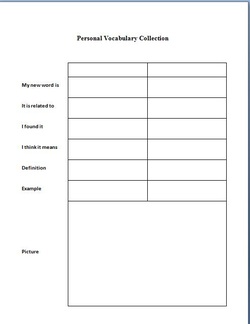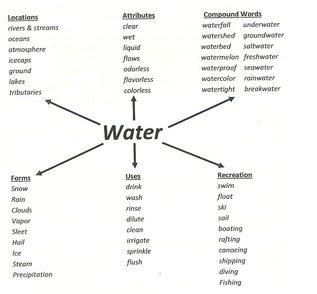Vocabulary Cubes
Purpose: To create relationships between unknown words and their meaning within a text. This activity will not only engage students in the text being read but also help them focus on comprehension after becoming experts on unfamiliar vocabulary words.
Best for: upper elementary through high school
How to implement:
*Before students begin reading, the teacher writes a list of important vocabulary words on the board that students may question during reading. This can be done during small group, whole group, or independent reading.
*During reading, when students come to an unknown word they do not know but feel it would help them comprehend the story being read, they add the word to the generated list on the board. If the vocabulary word is already a part of the list, students place a check mark beside of the word indicating the word is important in understanding the story.
*After reading, the class determines the most popular unknown vocabulary words and discusses possible meanings of each word (the amount of words depend on the grade level).
*Each student, pair, or group chooses one word to further research by using a dictionary, on-line resources, or peers/adults to discover the meaning. Each student, pair, or group is given a three dimensional cube template to record their findings. Two sections on the cube include the word being researched, while the other sections include the definition, picture, example (synonym), and non example (antonym).
*After completing each section of the cube, the students construct their cube and glue it to a popsicle stick.
*Finally as a small or whole group, students reread the original text aloud. When a student's vocabulary word comes up in the reading, the student(s) holds up their cube signifying an understanding of the word. An explanation of the word is then given to the class if still misunderstood by a peer.
Best for: upper elementary through high school
How to implement:
*Before students begin reading, the teacher writes a list of important vocabulary words on the board that students may question during reading. This can be done during small group, whole group, or independent reading.
*During reading, when students come to an unknown word they do not know but feel it would help them comprehend the story being read, they add the word to the generated list on the board. If the vocabulary word is already a part of the list, students place a check mark beside of the word indicating the word is important in understanding the story.
*After reading, the class determines the most popular unknown vocabulary words and discusses possible meanings of each word (the amount of words depend on the grade level).
*Each student, pair, or group chooses one word to further research by using a dictionary, on-line resources, or peers/adults to discover the meaning. Each student, pair, or group is given a three dimensional cube template to record their findings. Two sections on the cube include the word being researched, while the other sections include the definition, picture, example (synonym), and non example (antonym).
*After completing each section of the cube, the students construct their cube and glue it to a popsicle stick.
*Finally as a small or whole group, students reread the original text aloud. When a student's vocabulary word comes up in the reading, the student(s) holds up their cube signifying an understanding of the word. An explanation of the word is then given to the class if still misunderstood by a peer.
| cube_template.docx |
Word Scrolls
Purpose: To help dependent readers organize information and see relationships between words that may not be see. This is an interactive way to help students learn and retain new vocabulary words.
Best For:Elementary, middle and high school students.
Directions:
* Give a small group of students two or three new vocabulary words. Have each group complete the Word Scroll graphic organizer with each new vocabulary word. This organizer asks the students to define the word, identify two synonyms and two antonyms, provide four examples and use the word in a sentence.
* After completing the graphic organizer for each word, students are then asked to teach the class the new vocabulary words they have learned.
Example below
Best For:Elementary, middle and high school students.
Directions:
* Give a small group of students two or three new vocabulary words. Have each group complete the Word Scroll graphic organizer with each new vocabulary word. This organizer asks the students to define the word, identify two synonyms and two antonyms, provide four examples and use the word in a sentence.
* After completing the graphic organizer for each word, students are then asked to teach the class the new vocabulary words they have learned.
Example below
| word_scroll.doc |
Word Wheel
Purpose: To help students learn new vocabulary words and manipulate the definition through pictures and synonyms.
Best For: Middle and high school students.
Directions:
* Give the students a vocabulary word that should be written on the front of an index card.
* On the backside, there are four different sections. These sections include: the definition, a picture, synonyms and a sentence that contains context clues to the vocabulary word.
* This procedure can be repeated for all new vocabulary words.
Best For: Middle and high school students.
Directions:
* Give the students a vocabulary word that should be written on the front of an index card.
* On the backside, there are four different sections. These sections include: the definition, a picture, synonyms and a sentence that contains context clues to the vocabulary word.
* This procedure can be repeated for all new vocabulary words.
Personal Vocabulary Journal

Purpose: To help students increase vocabulary knowledge through self selection of vocabulary words.
BestFor: Elementary, middle and high school students.
Directions:
*Students self select a vocabulary word that has been read independently and misunderstood.
* Hand out a blank vocabulary form. Be sure to model this at first using a form on
the overhead/document camera.
* Students pick 2-3 vocabulary terms they want to learn the meaning of and then fill out the following vocabulary chart. This should include the word, what it is
related to, how it was found, what you think it means, definition, example
and picture.
Taylor, D.B. (2009). READ 6255 Presentation at Jesse Caron High School, Spring 2009
BestFor: Elementary, middle and high school students.
Directions:
*Students self select a vocabulary word that has been read independently and misunderstood.
* Hand out a blank vocabulary form. Be sure to model this at first using a form on
the overhead/document camera.
* Students pick 2-3 vocabulary terms they want to learn the meaning of and then fill out the following vocabulary chart. This should include the word, what it is
related to, how it was found, what you think it means, definition, example
and picture.
Taylor, D.B. (2009). READ 6255 Presentation at Jesse Caron High School, Spring 2009
| personal_vocabulary_jounal.doc |
Vocabulary Spelling Bee

Best for: upper Elementary through High
School
Directions:
Similar to a spelling bee,
the students hear a definition and they must tell the word that it defines to
stay in the game. If a student is incorrect, then he/she must sit
down. The game is played until one student remains.
School
Directions:
Similar to a spelling bee,
the students hear a definition and they must tell the word that it defines to
stay in the game. If a student is incorrect, then he/she must sit
down. The game is played until one student remains.
Semantic Mapping
Purpose: To add children in understanding and using as many words as possible based on a central concept.
Best For: Middle School and High School
Directions: The teacher provides a word that represents a central topic. The students then work to generate as many words as they can to relate to the central concept. Then the students group the words into broad categories that relate to the central concept.
Semantic Feature Analysis

Purpose: To add the children in seeing how topics are related in a visual form and therefore increasing their vocabulary.
Best For: Middle School to High School
Directions: Students are presented with a grid. On one axis, a set of related words are listed in olumns or rows. Then on the other axis, words are used that may or may not describe features of the
words on the first axis. Each cell has a plus ot a minus, depending upon whether the feature and word on the intersection of the row and column match. At first, students can be given a completed grid and asked to explain why each cell has a plus (+) or minus (-) in it. (Checks and X's can be used.) Later, students can be asked to enter the + or - and defend their thinking. Even later, students can create their own grids for analysis.
Best For: Middle School to High School
Directions: Students are presented with a grid. On one axis, a set of related words are listed in olumns or rows. Then on the other axis, words are used that may or may not describe features of the
words on the first axis. Each cell has a plus ot a minus, depending upon whether the feature and word on the intersection of the row and column match. At first, students can be given a completed grid and asked to explain why each cell has a plus (+) or minus (-) in it. (Checks and X's can be used.) Later, students can be asked to enter the + or - and defend their thinking. Even later, students can create their own grids for analysis.



